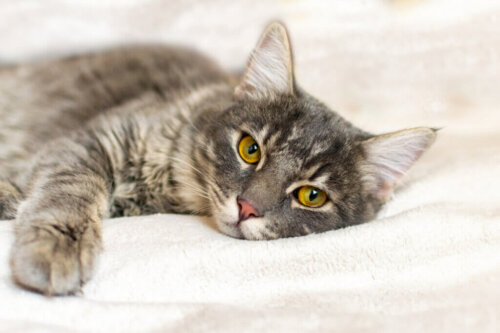What Are the Symptoms of Leukemia in Cats?

There are many pathological processes that we share with different animal species. In matters of disease, there’s more that unites pets and humans than what separates us. Today we’re going to talk about leukemia in cats.
This disease, typical to the feline patient, frequently occurs to street animals or those living in semi-free conditions. Do you know what causes this disease? Here we’ll tell you the signs and treatments of leukemia in cats.
Definition and etiology of leukemia in cats
Leukemia is considered one of the most common viral diseases among cats worldwide, especially those that live on the street and don’t benefit from adequate veterinary management.
This disease is caused by an RNA virus (retrovirus), which has three distinct subgroups, with varying degrees of prevalence. Consequently, each one of these has a different symptomatology in the cat. It has no predilection for breed or sex, but there’s a greater occurrence in males due to their street wandering habits.
Virus transmission is direct and horizontal, by inhalation or ingestion.
How leukemia manifests in cats
As already mentioned, it depends on the viral subgroup causing the infection, as well as on the idiosyncratic conditions of the animal, as subclinical infections may have an influence.
In this sense, about 70% of infections have non-neoplastic clinical processes, i.e. without development of tumors. In contrast, about 30% of leukemia virus infections cause tumors in cats.

Neoplastic type
Subgroup B of the virus is usually involved in the neoplastic type of leukemia. Cats infected with this viral subtype develop a specific type of tumor called lymphoma. Lymphoma is a malignant tumor consisting of abnormal lymphocytes at different stages of maturation.
This formation can affect several locations and its most frequent manifestation is the mediastinal lymphoma. The symptoms of mediastinal lymphoma are usually related to the pressure of the neoplastic mass on the adjacent structures. The infected cat may present the following symptoms:
- Breathing difficulty, more or less accentuated depending on the size of the tumor.
- Dysphagia, difficulty when eating or even drinking, caused by the compression of the esophagus.
- Horner’s syndrome, due to compression of the sympathetic nerves. This syndrome is related to the presence of ocular alterations, such as pupil contractions, drop of the eyelids, or protrusion of the third eyelid.
Multicentric lymphoma is the next most common form of manifestation. It affects the peripheral lymph nodes, the liver and the spleen. Therefore, symptoms may vary as they depend on the affected organ. The most common is the increase in the size of the lymph nodes, which is especially evident in the jaw area.
There’s another form involving the appearance of lymphomas in the intestinal tissue. However, its relationship with this virus is still controversial and a direct causal involvement hasn’t been established.
Non-neoplastic type
These infections are usually caused by subgroup A of the virus. The symptoms of the infected animals may include:
- Non-regenerative anemia: It’s estimated that about 75% of all cats with anemia are associated with the presence of the leukemia virus. Affected cats will show weakness, tiredness, and difficulty in breathing, as well as an evident paleness of the mucous membranes.
- Immune problems: This virus also affects the white blood cell count, that is, the cells in charge of body defenses. Therefore, sick cats are going to have a greater predisposition to develop infections of all kinds, from dermatitis to respiratory disease.
- Abortion and reproductive problems: Abortion and infertility are very common among infected cats. Moreover, the kittens born to a sick female will be weak, sickly and with a high neonatal mortality rate.

As you see, leukemia is a very frequent disease in cats. Therefore, it’s particularly important to include the vaccine against leukemia in the feline vaccination protocols, especially for those frequenting the streets. The vaccine is an effective measure of control of leukemia in cats.
